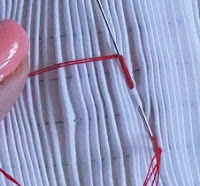There are two types of rolled hem that we see made by machine - the rolled hem we use in Heirloom Sewing and a machine rolled hem that we make with a special machine foot.
 |
| Three sizes shown here for each for a different weight of fabric. |
Some machine brands only offer one size but if you are lucky you will find that your machine has the option of more than one. The largest is for heavy weight fabrics or wider hems. The medium sizes is for fabrics like broadcloth. And the skinny one on the left is for very light weight fabrics like organdy. The best thing to do is experiment.
Starting a rolled hem so you have a beautiful, even beginning has always been the toughest part. Here is a little trick that will hopefully give you success.
Cut yourself a piece of waste fabric - it can be interfacing or scrap fabric but should be straight on two sides and about 6 inches long and 1- 2 inches wide.
The fabric you are going to hem should be trimmed of all the little threads left from tearing or raveling. These will just make the job harder.
Butt these edges of the waste fabric to your garment fabric. Now join these with a zigzag stitch or preferably a bridging stitch if you have one on your machine.
Here you can see my waste fabric attached with a bridging stitch. I've used coloured thread to make it easier for you to see what is happening.
Thread up your machine and bring the threads to the surface so you can put them behind the foot. Slide the waste fabric into the foot so it curls within the foot. Begin your stitching a couple of inches from the end of the waste fabric so you can get a good roll going. Stitch at an even medium speed even if you are tempted to rush through - it is not worth it to make an error!
While you are working on the waste fabric, check to be sure your stitching is to the left edge of the roll. This is the time to make any adjustments of this type.
Once this is checked you will want to watch the fabric feeding into the foot. This needs to be constant and the right amount of fabric. Not enough and there will be no roll. Too much and the raw edge will peek out of the roll.
 |
| Too little fabric |
 |
| Too much fabric |
 |
| Just right! |
Note how the fabric just rolls over my index finger.
When the stitching is finished, you can simply cut off the waste fabric, pick out any stray threads from the bridge stitching and voila you have a perfect rolled hem!
 |
| From the wrong side |
 |
| From the right side |
If anyone is interested, there is a neat way to finish a sleeve edge using a rolled hem so you don't have raw ends of seams exposed. Just let me know....

















